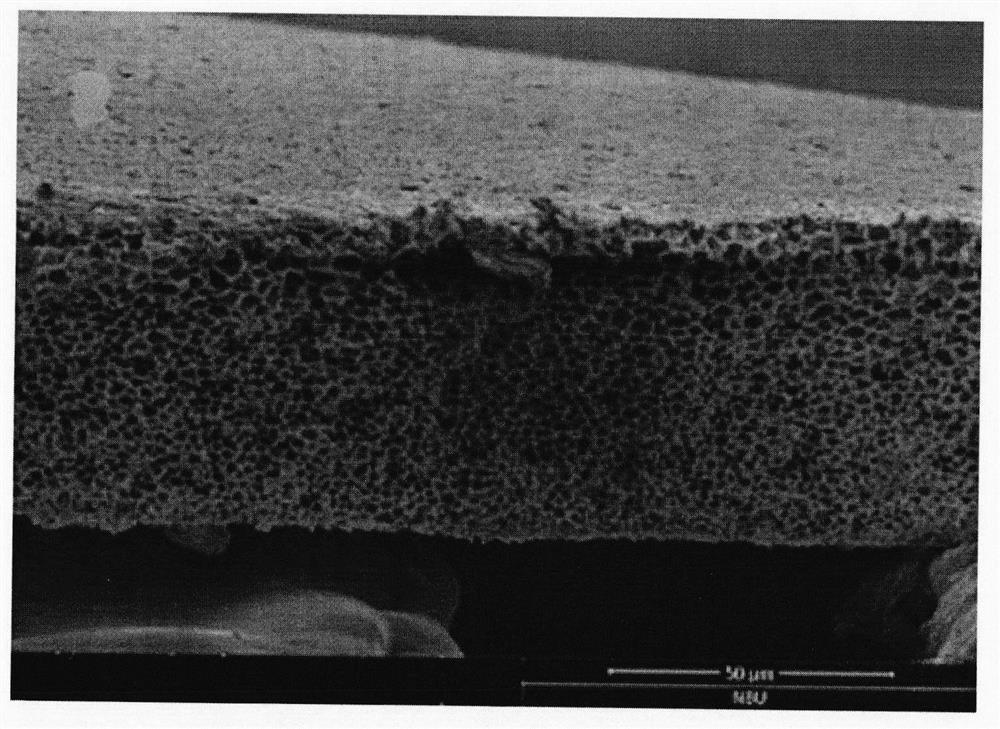A dry-wet phase conversion method for preparing microfiltration membrane
A technology of microfiltration membrane and phase inversion, applied in chemical instruments and methods, membrane technology, semi-permeable membrane separation, etc., can solve problems such as unsuitable for microfiltration application, difficult continuous production, low efficiency, etc.
- Summary
- Abstract
- Description
- Claims
- Application Information
AI Technical Summary
Problems solved by technology
Method used
Image
Examples
Embodiment 1
[0029]It is 12% by macromolecular PVDF mass percentage composition, the mass percentage composition of the second kind of macromolecular polyvinylpyrrolidone (PVP) is 11.5%, the solvent DMAc mass percentage composition is 68%, the quality of small molecule porogen magnesium chloride The percentage content is 8.5% to configure PVDF casting solution. First, magnesium chloride is completely dissolved in DMAc, then PVDF and PVP are added, stirred and heated at a constant temperature of 30°C to dissolve to form a completely uniform PVDF casting solution, and left to defoam. Afterwards, scrape the above-mentioned casting solution at 30°C, pour it on a glass plate, then use a scraper to make a 200 μm nascent film, and then keep the nascent film plate at 130°C for 60 seconds in an air atmosphere. , so that the nascent membrane phase separation occurs, and then put it into a water bath at 30 ° C to completely solidify the nascent membrane and fall off naturally, then put the PVDF membra...
Embodiment 2
[0031] It is 12% by macromolecular PVDF mass percentage composition, the mass percentage composition of the second kind of macromolecular polyvinylpyrrolidone (PVP) is 11.5%, the solvent DMAc mass percentage composition is 68%, the quality of small molecule porogen magnesium chloride The percentage content is 8.5% to configure PVDF casting solution. First, magnesium chloride is completely dissolved in DMAc, then PVDF and PVP are added, stirred and heated at a constant temperature of 30°C to dissolve to form a completely uniform PVDF casting solution, and left to defoam. Afterwards, the above-mentioned casting solution was scraped at 30°C, poured on a glass plate, and then scraped with a scraper to form a 220 μm nascent film, and then the nascent film was kept at 150°C for 45 seconds in an air atmosphere. , so that the nascent membrane phase separation occurs, and then put it into a water bath at 30 ° C to completely solidify the nascent membrane and fall off naturally, then put...
Embodiment 3
[0033] It is 12% by macromolecular PVDF mass percentage composition, the mass percentage composition of the second kind of macromolecular polyvinylpyrrolidone (PVP) is 4%, the solvent DMAc mass percentage composition is 73%, the quality of small molecule porogen magnesium chloride The percentage content is 11% to configure PVDF casting solution. Firstly, magnesium chloride is completely dissolved in DMAc, then PVDF and PVP are added, stirred and heated at a constant temperature of 35°C to dissolve to form a completely uniform PVDF casting solution, and left to defoam. Afterwards, the above-mentioned casting solution was scraped at 35° C., poured on a glass plate, and then scraped with a scraper to form a nascent eco-film, and then the nascent eco-film was kept at 100° C. for 30 seconds in an air atmosphere, so that The nascent eco-membrane undergoes phase separation, and then put it into a water bath at 35°C to completely solidify the nascent eco-membrane to form a film and fal...
PUM
| Property | Measurement | Unit |
|---|---|---|
| thickness | aaaaa | aaaaa |
| pore size | aaaaa | aaaaa |
| thickness | aaaaa | aaaaa |
Abstract
Description
Claims
Application Information
 Login to View More
Login to View More - R&D
- Intellectual Property
- Life Sciences
- Materials
- Tech Scout
- Unparalleled Data Quality
- Higher Quality Content
- 60% Fewer Hallucinations
Browse by: Latest US Patents, China's latest patents, Technical Efficacy Thesaurus, Application Domain, Technology Topic, Popular Technical Reports.
© 2025 PatSnap. All rights reserved.Legal|Privacy policy|Modern Slavery Act Transparency Statement|Sitemap|About US| Contact US: help@patsnap.com


